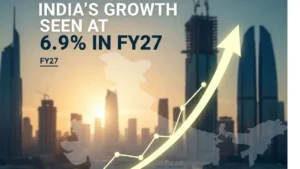In June 2024, India’s gross goods and services tax (GST) collection reached Rs 1.74 trillion, marking a 7.7% year-on-year growth, lower than previous months’ increases of 12.4% in April and 10% in May. Despite this slowdown, cumulative collections for the fiscal year stood at Rs 5.57 trillion. The finance ministry anticipates continued robust collections above Rs 1.6 trillion in the coming months, despite withholding detailed tax figures citing GST regime stability.
Breakdown of Collection and State Revenues
Central GST received Rs 39,600 crore from Integrated GST (IGST) collections, while states received Rs 33,548 crore. This data coincided with the seventh anniversary of GST rollout, celebrated under the theme “Sashakt Vyapar Samagra Vikas” (empowered trade, overall growth), highlighting reduced tax rates on household goods post-GST implementation.
Expert Insights and Industry Outlook
Experts like Pratik Jain from PwC India noted the encouraging trend in GST collections, urging the GST Council to consider rate rationalization. Saurabh Agarwal from EY credited effective enforcement and compliance measures for sustaining buoyancy in collections amidst economic stability.
GST : Key points
Introduction: GST (Goods and Services Tax) was introduced in India on July 1, 2017, replacing multiple indirect taxes levied by the central and state governments.
Tax Structure: It is a destination-based tax levied on consumption of goods and services. GST has five tax slabs: 0%, 5%, 12%, 18%, and 28%.
Dual Structure: GST has a dual structure with two components: Central GST (CGST) levied by the central government and State GST (SGST) levied by state governments.
Composition Scheme: Small businesses with turnover up to Rs 1.5 crore can opt for a composition scheme with simpler compliance and lower tax rates.
Input Tax Credit (ITC): Businesses can claim credit for taxes paid on inputs against the taxes collected on sales, reducing cascading effects.
GST Network (GSTN): It is the IT backbone of GST, handling registration, return filing, and invoice matching for taxpayers.
Compliance Measures: GST introduced simplified return filing processes like Quarterly Returns with Monthly Payment (QRMP) and reduced compliance burdens for small taxpayers.
Impact on Economy: GST aims to streamline taxation, reduce tax evasion, enhance transparency, and boost economic growth by creating a unified national market.
Recent Developments: There have been periodic updates in tax rates and compliance norms to simplify the GST regime and improve taxpayer experience.
Future Outlook: The GST Council periodically reviews rates and procedures to align with economic conditions and taxpayer feedback, aiming for continual improvement in the tax system.




 India’s Growth Seen at 6.9% in FY27 Desp...
India’s Growth Seen at 6.9% in FY27 Desp...
 India’s Forex Reserves Strengthen Near $...
India’s Forex Reserves Strengthen Near $...
 GST Collections Jump 6.1% in December 20...
GST Collections Jump 6.1% in December 20...







